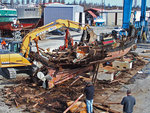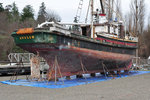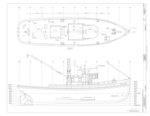A well-designed, well-built boat is a pleasure to look at, as well as being a repository of engineering knowledge, a tangible source of technical and historical information.
Aesthetics and …
This item is available in full to subscribers.
We have recently launched a new and improved website. To continue reading, you will need to either log into your subscriber account, or purchase a new subscription.
If you had an active account on our previous website, then you have an account here. Simply reset your password to regain access to your account.
If you did not have an account on our previous website, but are a current print subscriber, click here to set up your website account.
Otherwise, click here to view your options for subscribing.
* Having trouble? Call our circulation department at 360-385-2900, or email our support.
Please log in to continue |
|




A well-designed, well-built boat is a pleasure to look at, as well as being a repository of engineering knowledge, a tangible source of technical and historical information.
Aesthetics and nostalgia aside, however, fishing boats are built for making money, and sometimes an old boat would cost more to fix than it’s worth.
Such was the case with Avalon. Built at the Skansie Shipyard in Gig Harbor in 1929-30, Avalon had a long life as a commercial fishing vessel. After it sank Sept. 14, 2014 in Hood Canal, the Department of Natural Resources declared it derelict and seized the vessel to be destroyed.
That’s when Guy Hoppen of the Gig Harbor BoatShop stepped in.
“Given that Avalon was arguably the single most recognizable boat in Gig Harbor history, we wanted to slow the process long enough not only to gather data and construction details from the boat, but also to recover nearly 30 historic artifacts that are being catalogued and preserved,” Hoppen wrote in an email to the Leader. “We contracted with Jack [Becker] to do the data collecting for shape and construction details.”
The Port Townsend Shipwrights Co-op was selected to deconstruct the boat in a manner that allowed for Becker, Tim Lee of the Shipwrights’ Co-op, and Hoppen “to gather hidden construction details, collect artifacts ... and to photograph the process,” Hoppen wrote.
Becker, a Port Townsend draftsman and boatbuilder, is now wrapping up his documentation of Avalon, which he’s been working on part-time, on and off, for about three months. His photos and scale drawings, combined with written descriptions prepared by the Gig Harbor Boatshop, and large-format black-and-white photos by Jason Bledsoe, are to be submitted for inclusion in the Historic American Engineering Record (HAER), which documents achievements in American engineering, such as mills, power plants, dams, steamships and fishing vessels. HAER is one of a series of programs managed by the National Park Service’s Heritage Documentation Programs.
“The idea is someone could take the drawings and rebuild” the vessel, Becker said. “Obviously, no one’s going to build a new Avalon, because that would cost a fortune.” But the documentation is a way of preserving the vessel.
He took hundreds of photographs of Avalon, from many angles, and then used photogrammetry to create a three-dimensional model with PhotoScan software. On his computer screen, he can pick up and twirl the enormous 66-foot vessel and see it from any angle.
He exported the 3-D image to another 3-D modeling program called Rhinoceros, which allows him to slice and dice and create detailed line drawings of the boat’s shape, as well as construction drawings that document its structure and details.
Armed with a tape measure and a notebook, Becker crawled all over every inch of Avalon, measuring, sketching and taking detailed notes. He brought that notebook, each page crammed with drawings and measurements, home to his computer to add ever more accurate information to the computer-aided design (CAD) drawings, which are done on a scale of a half-inch to the foot.
“I was just crawling around, measuring, making sketches and notes,” he said. “I kind of went overboard on some stuff – like the steering gear. Not many people would draw the actual links” in the chain connected to the wheel.
He also “went overboard” on the windows, he said, bringing up his drawing of the deckhouse’s curved front, which had windows that could be dropped down into the wall. Detail drawings show the structure of the teak window frames’ mortise and tenon joints, and the small cam lock that would hold the window in place when it was dropped down into the slot.
“Those joints were still tight,” Becker said, joking that the boat’s destruction could serve as an object lesson for boat owners.
“It was extremely well built,” Becker said of Avalon. “It was really just lacking in maintenance.”
A comparable boat, the 1937 Western Flyer, is undergoing restoration in Port Townsend that is expected to cost about $2 million. Once chartered by author John Steinbeck, the Western Flyer is slated to become a platform for marine science education.
On March 5, Becker took more photos and videos as Avalon was demolished by Shipwrights Co-op members using excavators. Metal was saved for recycling; most of the rest went into dumpsters.
Becker climbed over the debris when the workers took breaks. “They were pretty cooperative about letting me jump in at different times,” he said. As the frames and other unseen parts were exposed, “I would walk over and measure,” Becker said.
Avalon was built mostly of fir, with ironbark used for cap rails, rub rails and other high-wear parts. Most of the keel and stem were “big, massive hunks of fir,” Becker said. Rotten areas were exposed during demolition, he recalled.
He praised the boat’s design. “A very sleek hull,” he said.
Becker, originally from Virginia, studied aerospace engineering at Virginia Tech before moving to California in the mid-1970s. There, he restored a 37-foot wooden sailboat in the San Francisco Bay Area, and worked as a draftsman for an engineering consulting firm. He and his wife, Elizabeth, later moved to Portland, Oregon, where he continued his career in design and drafting, until Elizabeth enrolled him at the Northwest School of Wooden Boatbuilding in 1997, when they came to Port Townsend.
“We just never left,” he said.
After boat school, “I did a little drafting on the side, but mostly worked in the boatyard,” he said. He did in-house design for Townsend Bay Marine for eight years, and in 2010-2011, he served as an instructor at the boat school. While there, he and Pete Leenhouts went to a workshop at The Center for Wooden Boats’ Cama Beach facility on Camano Island, where they learned about HAER guidelines for documenting boats.
“My drafting background and my interest in boats kind of aligned with that,” Becker said. After the workshop, “Little documentation projects kept coming up – mostly for small boats in Lake Union.”
“The documentation process is exhaustive, and involves a great deal of attention to detail,” Leenhouts said. “The vessel is thoroughly and accurately measured so that its lines and scaled construction drawings can be made. Every detail is documented. Large-scale photography is accomplished, too, to exacting standards.… Jack, quite frankly, has developed a reputation for the extraordinary attention to detail and the quality of his work.”
“I have my eye on a couple other boats that are not slated for disposal, but that we would like to document,” said Hoppen, board president of the Gig Harbor BoatShop. “Jack’s part in the Avalon documentation and any future documentation efforts is certainly the key component. There are not many that have the package of skills he has developed. So we hope to work with him again soon. As soon as he recovers from this first go-around.”